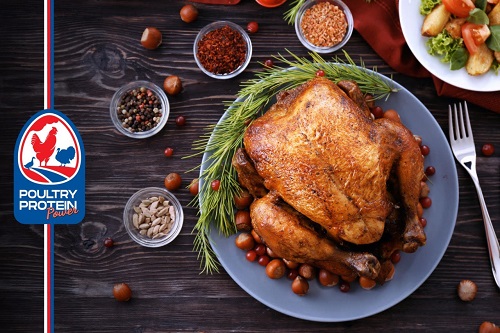Poultry Protein Power: Proteins are the Building Blocks of the Body
Protein, the macronutrient, essential for growth and repair is needed on a daily basis as part of our healthy balanced diet. It plays a crucial role in the functioning of the body like the development of immunity, production of hormones, enzymes and haemoglobin. Poultry products are ideal for boosting immunity, production of hormones, enzymes and hemoglobin Children have higher requirements due to growth, building a strong immunity and prevention of infections. Also as we grow, proteins have an additional function of giving muscle strength, helps in weight loss, besides building immunity and being the basics for all cells. Similarly, as we age protein is very essential to prevent getting infections, also helps in faster and quicker recovery post illness. So what's the RDA for protein requirement Requirement defers with age, sex, activity pattern and the state of health. Recommendations are given by NIN 2020. Age Group Protein Men 55g Women 45-50g Children (1-3yrs) 4-9yrs 10-15g 15-25g Children Boys 10-12 Girls 10-12 yrs 31.8g 32.8g Boys 13-15 Girls 13-15 yrs 44.9g 43.2g Boys 16-18 yrs Girls 16-18 yrs 55.4g 46.2g *NIN summary of RDA for indians -2020 The latest survey by the Indian Market Research Bureau (IMRB) to ascertain the levels of protein deficiency and awareness about protein in India showed 73% of urban rich is protein deficient with 93% of them unaware about what proteins to take and what's their daily protein requirements. Boost Poultry Protein Intake The RDA of protein (NIN ICMR 2020) is 46g and 54g/day for reference women and men respectively. North India is found to meet only 50% of the recommended amount of protein. Both in the rural and urban India, it is observed that the protein contribution was from poor quality sources such as cereals and millets. The diet consumed by Asian Indians are high on carbohydrates, fats and sugar and low in protein. The overall protein quality is found to be low which has an impact on the muscle mass and low immunity. As per the NIN-ICMR's What India Eats report (2020), the total protein intake was higher in the central India (48.6g/d) followed by Northeast (41.2 g/day) and was lowest in the North (21.8g/day). Cereals and millets contributed to the highest proportion of protein intakes in both urban (26.3 g/day) and rural India (33.4 g/d) among all food groups. The next food group that contributed to protein intake was pulses & legumes (8.2 g/day), which represented 14.8% of total contribution of protein among all food groups in urban India. And meat, poultry, fish and seafoods contributed to 11.6% of total protein intakes that ranged from 2.2% in the central to 16.9% in the south. Southern region had the highest intake of protein form flesh foods for both urban and rural areas. Hence there is a need to create awareness on the importance of protein on our health, how much to take and the sources of protein in our diet. It is important to understand the quality of protein when we include them in our diets. Quality of protein can be defined by its bio availability and its amino acid profile. Poultry like Chicken, duck, turkey and eggs are one of the best source of bioavailable proteins and are termed as complete proteins since all the dietary essential amino acids are abundantly present in them. Complete protein sources like chicken, turkey, duck and egg are high on quantity and 100% digested. They are packed with the goodness of healthy proteins, fats and micronutrient, and its high protein content makes it a great immunity boosting food. Besides being an excellent source of protein, they are also loaded with micronutrients like vitamin A, Vitamin B12, Zinc, Iron, selenium. So taking an example of adult Indian women, whose requirement of protein is approx. 45-50g/ day. Taking a serving of chicken which is around 100g (3oz) gives around 20g which is more than 1/3rd the total requirement. So when we talk about protein intake, which is such an important nutrient for health, we must focus on both on quantity and quality. Talking about quality of protein especially in poultry, as it is nutritionally rich and highly perishable in nature, are at high risk of contamination and spoilage. Microbial pathogens ma

Protein, the macronutrient, essential for growth and repair is needed on a daily basis as part of our healthy balanced diet. It plays a crucial role in the functioning of the body like the development of immunity, production of hormones, enzymes and haemoglobin.
 |
Poultry products are ideal for boosting immunity, production of hormones, enzymes and hemoglobin
Children have higher requirements due to growth, building a strong immunity and prevention of infections. Also as we grow, proteins have an additional function of giving muscle strength, helps in weight loss, besides building immunity and being the basics for all cells. Similarly, as we age protein is very essential to prevent getting infections, also helps in faster and quicker recovery post illness.
So what's the RDA for protein requirement Requirement defers with age, sex, activity pattern and the state of health. Recommendations are given by NIN 2020.
|
Age Group |
Protein |
|
Men |
55g |
|
Women |
45-50g |
|
Children (1-3yrs) 4-9yrs
|
10-15g 15-25g |
|
Children Boys 10-12 Girls 10-12 yrs |
31.8g 32.8g |
|
Boys 13-15 Girls 13-15 yrs |
44.9g 43.2g |
|
Boys 16-18 yrs Girls 16-18 yrs |
55.4g 46.2g |
|
*NIN summary of RDA for indians -2020 |
|
The latest survey by the Indian Market Research Bureau (IMRB) to ascertain the levels of protein deficiency and awareness about protein in India showed 73% of urban rich is protein deficient with 93% of them unaware about what proteins to take and what's their daily protein requirements.
 |
Boost Poultry Protein Intake
The RDA of protein (NIN ICMR 2020) is 46g and 54g/day for reference women and men respectively. North India is found to meet only 50% of the recommended amount of protein. Both in the rural and urban India, it is observed that the protein contribution was from poor quality sources such as cereals and millets. The diet consumed by Asian Indians are high on carbohydrates, fats and sugar and low in protein. The overall protein quality is found to be low which has an impact on the muscle mass and low immunity.
As per the NIN-ICMR's What India Eats report (2020), the total protein intake was higher in the central India (48.6g/d) followed by Northeast (41.2 g/day) and was lowest in the North (21.8g/day). Cereals and millets contributed to the highest proportion of protein intakes in both urban (26.3 g/day) and rural India (33.4 g/d) among all food groups. The next food group that contributed to protein intake was pulses & legumes (8.2 g/day), which represented 14.8% of total contribution of protein among all food groups in urban India. And meat, poultry, fish and seafoods contributed to 11.6% of total protein intakes that ranged from 2.2% in the central to 16.9% in the south. Southern region had the highest intake of protein form flesh foods for both urban and rural areas.
Hence there is a need to create awareness on the importance of protein on our health, how much to take and the sources of protein in our diet. It is important to understand the quality of protein when we include them in our diets. Quality of protein can be defined by its bio availability and its amino acid profile. Poultry like Chicken, duck, turkey and eggs are one of the best source of bioavailable proteins and are termed as complete proteins since all the dietary essential amino acids are abundantly present in them. Complete protein sources like chicken, turkey, duck and egg are high on quantity and 100% digested. They are packed with the goodness of healthy proteins, fats and micronutrient, and its high protein content makes it a great immunity boosting food. Besides being an excellent source of protein, they are also loaded with micronutrients like vitamin A, Vitamin B12, Zinc, Iron, selenium.
So taking an example of adult Indian women, whose requirement of protein is approx. 45-50g/ day. Taking a serving of chicken which is around 100g (3oz) gives around 20g which is more than 1/3rd the total requirement. So when we talk about protein intake, which is such an important nutrient for health, we must focus on both on quantity and quality.
Talking about quality of protein especially in poultry, as it is nutritionally rich and highly perishable in nature, are at high risk of contamination and spoilage. Microbial pathogens may invade poultry products due to improper hygienic and sanitary practices during slaughtering and meat processing/handling, storage, transportation which poses a high risk of food borne infections/ illness. Freezing poultry is a simple and effective way to stock up on your protein of choice Freezing doesnt reduce the nutritional content of meat.
Poultry proteins including chicken, turkey, duck and eggs not only taste good but are also good for health.
![]()































































































